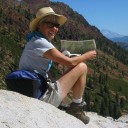Pyla dune—the highest sand dune in Europe
The last three posts touched on how the landscape of Bordeaux affects wine characteristics. But there are landscape features that are just fun for their own sake. Billed as the highest dune in Europe, we had to visit Pyla Dune, a geologic feature along the Atlantic coast south of Arcachon, a popular seaside that is an easy 52-minute train ride...
Biking between two rivers—the Entre-Deux-Mers region
The Entre-Deux-Mers region is located between the Garonne and Dordogne Rivers that feed into the Gironde estuary. The name, though, is "between two seas" or "between two tides" because the rivers have a tidal influence. The Gironde has a large tidal range and during the largest tides, a tidal bore (single wave) will move upstream in the rivers. One of...
The terroir of Saint Emilion
The terroir of the Saint Emilion AOC (see roundish purple region on the Right Bank in previous post) differs from that of the Médoc (of course). The climate has less of a maritime influence, and the limestone bedrock is close to the surface, with only thin, mostly clay-rich soils. We visited just one Chateau—Troplong Modot. Notice that the rocks in this...
Terroir extraordinaire—a key to understanding the wines in Bordeaux (and elsewhere in France)
The ancient Greeks understood the effects of location on wine characteristics, but it was the French who really ran with the concept, coining the term "terroir" and making it an essential aspect of their appellation d'origine controlée (AOC), the controlled designation of origin that is granted to wine, and other agricultural products, based on the location where the product is...
About the Blogger
 Karen (here with Mt. Shasta in background) is a geology professor emerita who aims to provide a "pocket geologist" for world travelers. Follow the blog to explore the landscapes of our planet and figure out what causes them to look the way they do.
Karen (here with Mt. Shasta in background) is a geology professor emerita who aims to provide a "pocket geologist" for world travelers. Follow the blog to explore the landscapes of our planet and figure out what causes them to look the way they do.





